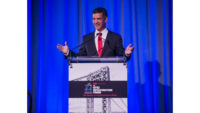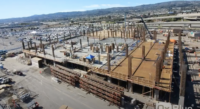Working through New York City's 10-year, $160-billion-plus capital plan will require a holistic approach, according to Alison Landry, chief infrastructure officer in the Office of the Deputy Mayor.
Speaking at ENR's NYNJ Infrastructure Forum held Sept. 16 in New York City, Landry emphasized the idea of a “complete project” in which all city infrastructure is intertwined. “We're thinking about these systems as the metabolism of our city, all of the things that hold it all together and help people go about their day without having to think about it very much,” she said.
Landry noted that there are 300,000 city streetlights “and every single one of those has bits and pieces that somebody has to maintain, components that people have to track at the system scale, things that have to be designed, things that have to be replaced, things that have to work together.”
While the city maintains 800 bridges, “what about Amtrak? What about the state DOT? What about the port? There are so many different players here … there's a whole interrelated metabolism with all of these other public owners.”
She added: “Each of us has a little piece to play in this puzzle, but it all comes together, and that's what helps us make sure that people have their needs met in our city. We really do need all hands on deck, because there's so much work to do.”
In the city's 10-year capital plan of over $160 billion, projects are aimed not just at redundancy in case of crises, but also to serve multiple functions. A new pedestrian bridge is not only ADA compliant but also provides access to new athletic facilities and parks. “Last week we opened a new playground in the Bronx that is a cloudburst. So it absorbs 800,000 gallons of stormwater annually … so it's all part of the same ecosystem where things are doing more than one function, and we're really getting that higher performance from our work."
Resilience, one of the forum’s major themes, “is embedded in every single project that we’re doing today,” she said. “We’re starting to think about more extreme weather, things like heat and intense rainfall,” Landry said. “We know we're in a housing crisis. This is something that's being talked about at all levels of government, and there are so many tools that the city is using to tackle that housing crisis. But in support of that, we must build infrastructure… this isn't just about addressing known deficiencies or chronic issues like flooding or capacity, but also thinking about the future growth and demand as certain neighborhoods experience population change.”
Alternative Project Delivery Gains Fans in NYC
Eric Mcfarlane, first deputy commissioner for the New York City Dept. of Design and Construction, detailed agency plans to deliver projects better, faster and cheaper by reforming the capital delivery process together with city and industry partners.
The agency responsible for more than $30 billion in capital construction is piloting a program that allows it to further expand use of design-build, which requires state permission for each project. But the 23 design-build projects in its current portfolio are mostly non-infrastructure projects because Mcfarlane says deploying design-build in the infrastructure sector is still “tough” given that determining a project’s full scope before it breaks ground is difficult. “It’s hard to know what’s under the street with great accuracy,” he said. “To ask somebody for design-build and to give me a guarantee maximum price upfront is almost impossible.”
DDC selected five infrastructure projects ranging in value from $5 million to $90 million for a progressive design-build pilot program. The phased projects allow teams to determine a more exact project scope “before you put a price on the project,” Mcfarlane said. The pilot also is helping to train DDC staff, other city agencies and industry partners that have been had a design-bid-build mindset for decades, he added. “This requires a real change in mentality of the way we approach things,” Mcfarlane said.
The agency that was named as 2023 ENR New York Owner of the Year has also been lobbying state legislators to act on recommendations offered by the capital process reform task force launched by Mayor Eric Adams—including to transform DDC from a city agency into a state authority, allowing it to fully revamp its procurement rules.
“If we become an authority we would have more flexibility,” Mcfarlane said. “That’s a long shot but we are still trying to pursue that.”
DDC also hopes Gov. Kathy Hochul (D) extends the “Joint Bidding” law set to sunset in December. Should the sunset not be extended, the city will lose its authority to use joint bidding. DDC said bidding street, water and sewer infrastructure projects with gas, electric and communications utilities sharing space beneath the street under a single contract shaves years off project schedules.
“All we are trying to do is essentially build a project faster,” Mcfarlane said.
Another pilot program streamlining change orders also would help the agency build faster. It places a clause in project contracts providing expanded work allowance covering the most common types of change orders. Mcfarlane said these are predictable because they occur in areas where “we don’t have complete information.”
The projects in the pilot allot money to pay at least 80% of the change order immediately, “while we negotiate the final amount ... and we also put incentives for early completion in our contract ... [to] facilitate our construction and make sure vendors are not suffering financially,” he said.
Historically, capital project change orders take nine-month to resolve, “which is absolutely absurd,” Mcfarlane said. That enables "only construction companies that have the financial revenue [to] work with the city.”
The department is also working on a five-year blueprint to better manage and execute the projects in its portfolio. One
priority is to enhance coastal resilience and protect the city from the impact of climate change,” Mcfarlane said. DDC is also collaborating with the New York City Dept. of Environmental Protection and other agencies to implement best practices for stormwater management, shoreline stabilization, wetland restoration and flood mitigation.
He said DDC has “a significant amount of work to do and I hope it will inspire the next generation of engineers and architects to pursue their passions and continue the work.”






